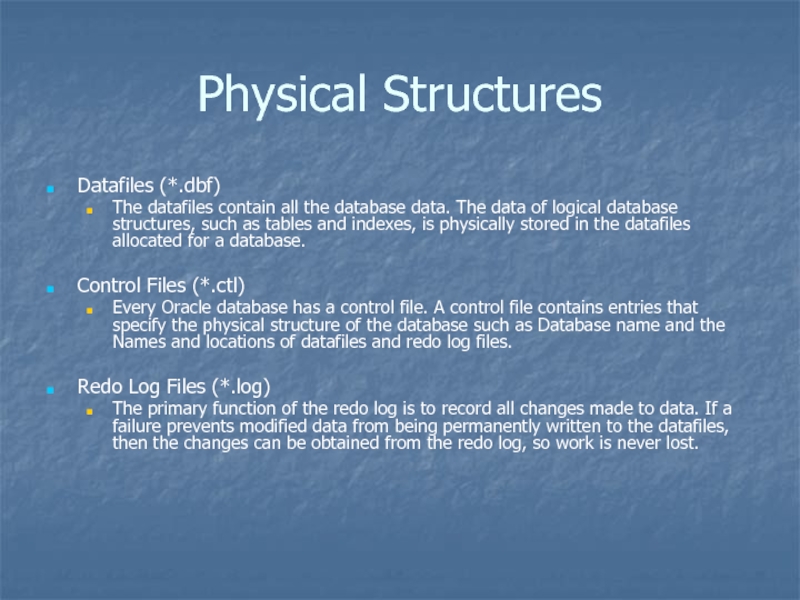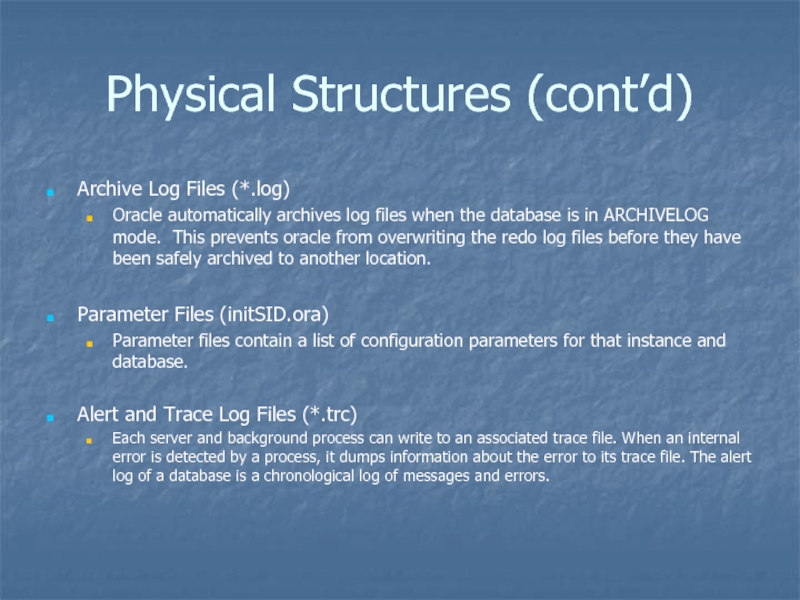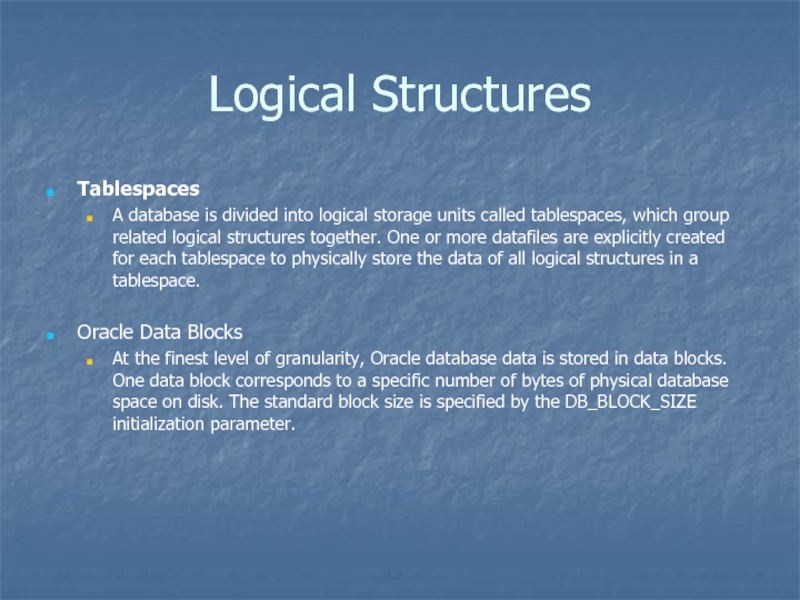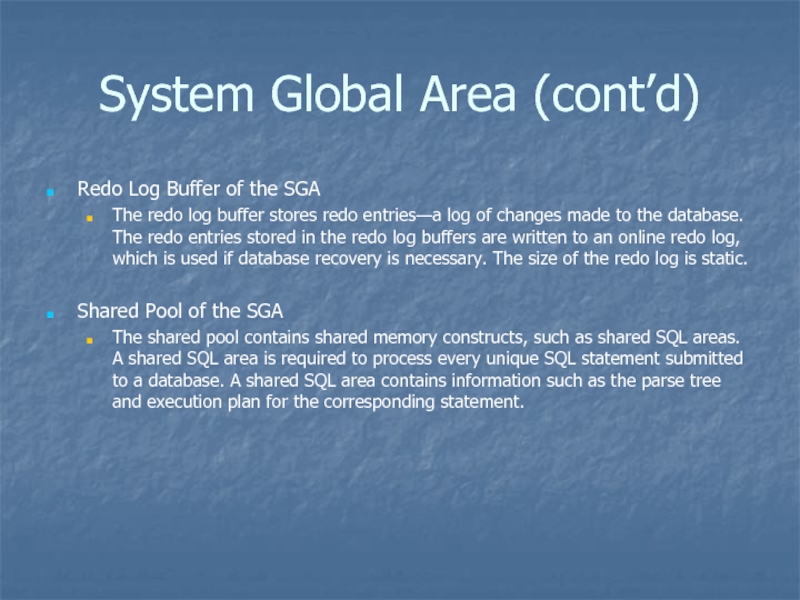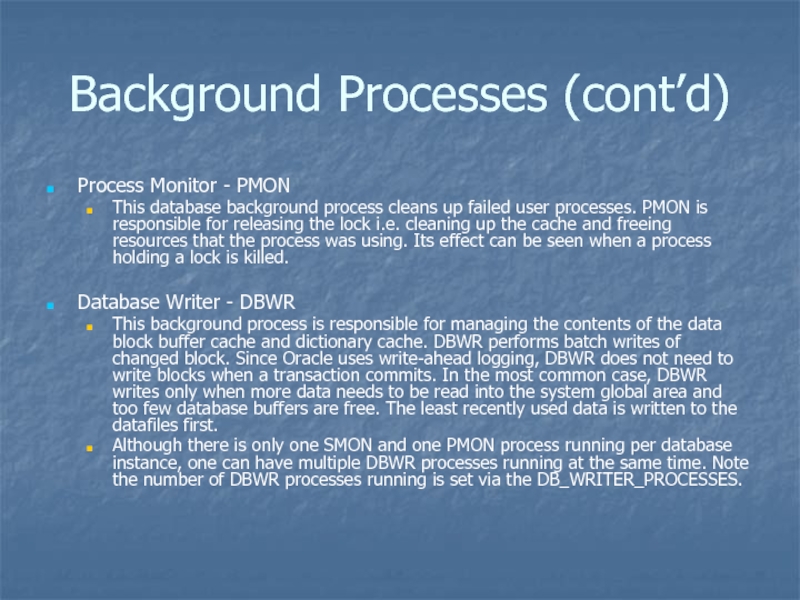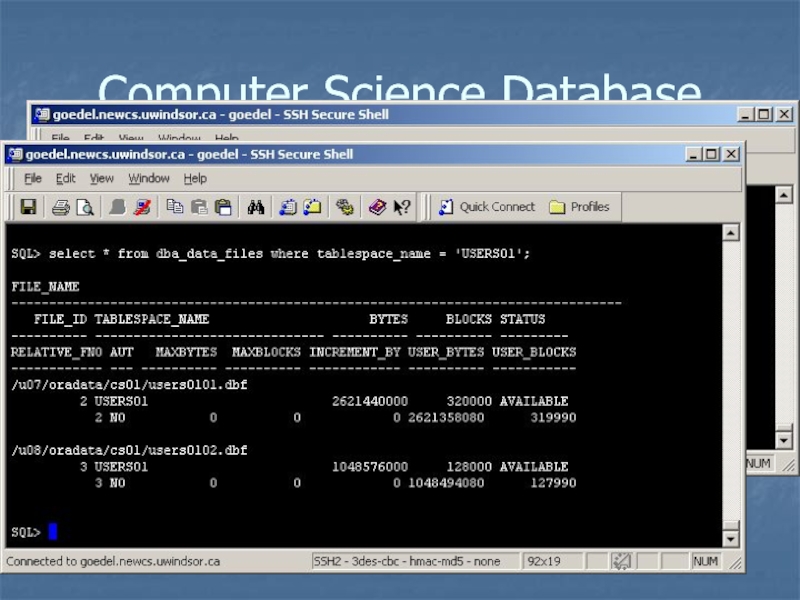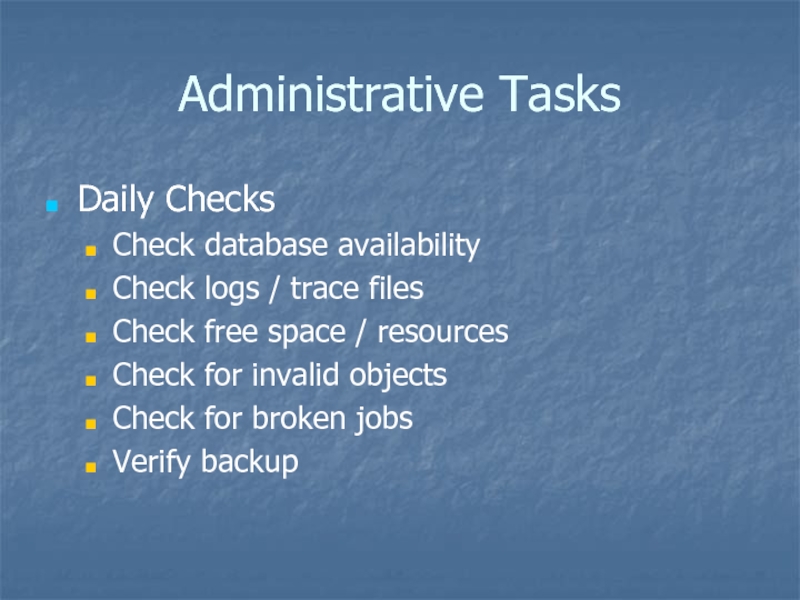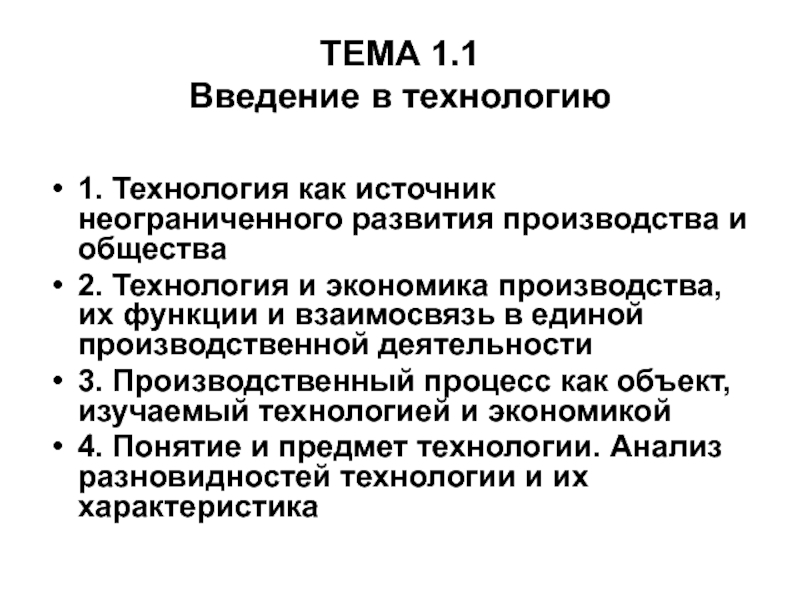Разделы презентаций
- Разное
- Английский язык
- Астрономия
- Алгебра
- Биология
- География
- Геометрия
- Детские презентации
- Информатика
- История
- Литература
- Математика
- Медицина
- Менеджмент
- Музыка
- МХК
- Немецкий язык
- ОБЖ
- Обществознание
- Окружающий мир
- Педагогика
- Русский язык
- Технология
- Физика
- Философия
- Химия
- Шаблоны, картинки для презентаций
- Экология
- Экономика
- Юриспруденция
Introduction to Oracle
Содержание
- 1. Introduction to Oracle
- 2. Слайд 2
- 3. Physical StructuresDatafiles (*.dbf)The datafiles contain all the
- 4. Physical Structures (cont’d)Archive Log Files (*.log)Oracle automatically
- 5. Logical StructuresTablespacesA database is divided into logical
- 6. Logical Structures (cont’d)ExtentsThe next level of logical
- 7. Logical Structures (cont’d)Schema OverviewA schema is a
- 8. Слайд 8
- 9. Oracle InstanceAn Oracle database server consists of
- 10. System Global Area (SGA) The System Global Area
- 11. System Global Area (cont’d)Redo Log Buffer of
- 12. Program Global Area (PGA) PGA is a memory
- 13. Oracle Background Processes An Oracle database uses memory
- 14. Background Processes (cont’d)Process Monitor - PMONThis database
- 15. Background Processes (cont’d)Log Writer - LGWRThis background
- 16. Background Processes (cont’d)Checkpoint - CKPTAll modified information
- 17. Слайд 17
- 18. Computer Science DatabaseServer InformationSun e45008GB Ram8 x 400mhz CPU32GB Disk for Oracle4mm DAT DDS3 Tape Backup
- 19. Computer Science DatabaseInstance Name : CS01 (v$database)Instance
- 20. Слайд 20
- 21. Backup MethodsCold Backup (aka Consistent Backups)The only
- 22. Backup Methods (cont’d)Hot Backup (aka Inconsistent Backups)If
- 23. Backup Methods (cont’d)Logical backup (Export)Logical backups are
- 24. Administrative TasksDaily ChecksCheck database availabilityCheck logs /
- 25. Administrative Tasks (cont’d)Weekly TasksCollect statistics (database job)Archive / delete log filesRun performance reports (statspack)
- 26. Administrative Tasks (cont’d)OthersApplying patchesDatabase upgradesNew Database installationsCreating user accounts
- 27. More InformationOracle 10g Release 2 Database Documentation
- 28. Скачать презентанцию
Physical StructuresDatafiles (*.dbf)The datafiles contain all the database data. The data of logical database structures, such as tables and indexes, is physically stored in the datafiles allocated for a database. Control
Слайды и текст этой презентации
Слайд 3Physical Structures
Datafiles (*.dbf)
The datafiles contain all the database data. The
data of logical database structures, such as tables and indexes,
is physically stored in the datafiles allocated for a database.Control Files (*.ctl)
Every Oracle database has a control file. A control file contains entries that specify the physical structure of the database such as Database name and the Names and locations of datafiles and redo log files.
Redo Log Files (*.log)
The primary function of the redo log is to record all changes made to data. If a failure prevents modified data from being permanently written to the datafiles, then the changes can be obtained from the redo log, so work is never lost.
Слайд 4Physical Structures (cont’d)
Archive Log Files (*.log)
Oracle automatically archives log files
when the database is in ARCHIVELOG mode. This prevents oracle
from overwriting the redo log files before they have been safely archived to another location.Parameter Files (initSID.ora)
Parameter files contain a list of configuration parameters for that instance and database.
Alert and Trace Log Files (*.trc)
Each server and background process can write to an associated trace file. When an internal error is detected by a process, it dumps information about the error to its trace file. The alert log of a database is a chronological log of messages and errors.
Слайд 5Logical Structures
Tablespaces
A database is divided into logical storage units called
tablespaces, which group related logical structures together. One or more
datafiles are explicitly created for each tablespace to physically store the data of all logical structures in a tablespace.Oracle Data Blocks
At the finest level of granularity, Oracle database data is stored in data blocks. One data block corresponds to a specific number of bytes of physical database space on disk. The standard block size is specified by the DB_BLOCK_SIZE initialization parameter.
Слайд 6Logical Structures (cont’d)
Extents
The next level of logical database space is
an extent. An extent is a specific number of contiguous
data blocks, obtained in a single allocation, used to store a specific type of information.Segments
Above extents, the level of logical database storage is a segment. A segment is a set of extents allocated for a certain logical structure. The different types of segments are :
Data segment – stores table data
Index segment – stores index data
Temporary segment – temporary space used during SQL execution
Rollback Segment – stores undo information
Слайд 7Logical Structures (cont’d)
Schema Overview
A schema is a collection of database
objects. A schema is owned by a database user and
has the same name as that user. Schema objects are the logical structures that directly refer to the database's data. Schema objects include structures like tables, views, and indexes.Слайд 9Oracle Instance
An Oracle database server consists of an Oracle database
and an Oracle instance. Every time a database is started,
a system global area (SGA) is allocated and Oracle background processes are started. The combination of the background processes and memory buffers is called an Oracle instance.Слайд 10System Global Area (SGA)
The System Global Area (SGA) is a
shared memory region that contains data and control information for
one Oracle instance. Users currently connected to an Oracle database share the data in the SGA. The SGA contains the following memory structures :Database Buffer Cache
Database buffers store the most recently used blocks of data. The set of database buffers in an instance is the database buffer cache. The buffer cache contains modified as well as unmodified blocks. Because the most recently (and often, the most frequently) used data is kept in memory, less disk I/O is necessary, and performance is improved.
Слайд 11System Global Area (cont’d)
Redo Log Buffer of the SGA
The redo
log buffer stores redo entries—a log of changes made to
the database. The redo entries stored in the redo log buffers are written to an online redo log, which is used if database recovery is necessary. The size of the redo log is static.Shared Pool of the SGA
The shared pool contains shared memory constructs, such as shared SQL areas. A shared SQL area is required to process every unique SQL statement submitted to a database. A shared SQL area contains information such as the parse tree and execution plan for the corresponding statement.
Слайд 12Program Global Area (PGA)
PGA is a memory buffer that contains
data and control information for a server process. A server
process is a process that services a client’s requests. A PGA is created by oracle when a server process is started. The information in a PGA depends on the oracle configuration. The PGA area is a non-shared area of memory created by oracle when a server process is started. The basic difference between SGA and PGA is that PGA cannot be shared between multiple processes in the sense that it is used only for requirements of a particular process whereas the SGA is used for the whole instance and it is shared.Слайд 13Oracle Background Processes
An Oracle database uses memory structures and processes
to manage and access the database. All memory structures exist
in the main memory of the computers that constitute the database system. Processes are jobs that work in the memory of these computers.Oracle creates a set of background processes for each instance. The background processes consolidate functions that would otherwise be handled by multiple Oracle programs running for each user process. They asynchronously perform I/O and monitor other Oracle processes to provide increased parallelism for better performance and reliability.
The most common background processes are :
System Monitor – SMON
This database background process performs instance recovery at the start of the database. SMON also cleans up temporary segments that are no longer in use and recovers dead transactions skipped during crash and instance recovery because of file-read or offline errors. It coalesces i.e. combines contiguous free extents into larger free extents.
Слайд 14Background Processes (cont’d)
Process Monitor - PMON
This database background process cleans
up failed user processes. PMON is responsible for releasing the
lock i.e. cleaning up the cache and freeing resources that the process was using. Its effect can be seen when a process holding a lock is killed.Database Writer - DBWR
This background process is responsible for managing the contents of the data block buffer cache and dictionary cache. DBWR performs batch writes of changed block. Since Oracle uses write-ahead logging, DBWR does not need to write blocks when a transaction commits. In the most common case, DBWR writes only when more data needs to be read into the system global area and too few database buffers are free. The least recently used data is written to the datafiles first.
Although there is only one SMON and one PMON process running per database instance, one can have multiple DBWR processes running at the same time. Note the number of DBWR processes running is set via the DB_WRITER_PROCESSES.
Слайд 15Background Processes (cont’d)
Log Writer - LGWR
This background process manages the
writing of the contents of the redo log buffer to
the online redo log files. LGWR writes the log entries in batch form. The Redo log buffers entries always contain the most up-to-date status of the database.Archiver - ARCH
The Archiver process reads the redo log files once Oracle has filled them and writes a copy of the used redo log files to the specified archive log destination(s). Actually, for most databases, ARCH has no effect on the overall system performance. On some large database sites, however, archiving can have an impact on system performance.
Слайд 16Background Processes (cont’d)
Checkpoint - CKPT
All modified information in database buffer
in the SGA is written to the datafiles by a
database write process (DBWR). This event indicates a checkpoint. The checkpoint process is responsible for signaling DBWR at checkpoints and updating all of the datafiles and control files of the database.Recover - RECO
The recover process automatically cleans up failed or suspended distributed transactions.
Job Queue Processes
Job queue processes are used for batch processing. They run user jobs. They can be viewed as a scheduler service that can be used to schedule jobs as PL/SQL statements or procedures on an Oracle instance. Given a start date and an interval, the job queue processes try to run the job at the next occurrence of the interval.
Слайд 18Computer Science Database
Server Information
Sun e4500
8GB Ram
8 x 400mhz CPU
32GB Disk
for Oracle
4mm DAT DDS3 Tape Backup
Слайд 19Computer Science Database
Instance Name : CS01 (v$database)
Instance Version : 8.1.6.0.0
Tablespaces
: (dba_tablespaces)
SYSTEM – holds all system tables
INDEX01 – user indexes
USERS01
– user tablesUSERS02 – user tables (faculty)
RBS – rollback segments
Слайд 21Backup Methods
Cold Backup (aka Consistent Backups)
The only way to make
a consistent whole database backup is to shut down the
database with the NORMAL, IMMEDIATE, or TRANSACTIONAL options and make the backup while the database is closed.Advantage : No recovery is required after datafiles are restored – quicker restore
Disadvantage : No access to database during backup time (depends on size/system speed)
Слайд 22Backup Methods (cont’d)
Hot Backup (aka Inconsistent Backups)
If the database must
be up and running 24 hours a day, seven days
a week, then you have no choice but to perform inconsistent backups of the whole database. A backup of online datafiles is called an online backup. This requires that you run your database in ARCHIVELOG mode.Advantage : Database remains open during backup
Disadvantage : Large databases may have performance impact during backup, recovery takes longer and is slightly more complex
Слайд 23Backup Methods (cont’d)
Logical backup (Export)
Logical backups are exports of schema
objects, like tables and stored procedures, into a binary file.
Oracle utilities are used to move Oracle schema objects in and out of Oracle.Not recommended for backup of a whole database, but useful for backing up individual objects or schemas or moving data into another database
Слайд 24Administrative Tasks
Daily Checks
Check database availability
Check logs / trace files
Check free
space / resources
Check for invalid objects
Check for broken jobs
Verify backup
Слайд 25Administrative Tasks (cont’d)
Weekly Tasks
Collect statistics (database job)
Archive / delete log
files
Run performance reports (statspack)
Слайд 26Administrative Tasks (cont’d)
Others
Applying patches
Database upgrades
New Database installations
Creating user accounts
Слайд 27More Information
Oracle 10g Release 2 Database Documentation
http://www.oracle.com/pls/db102/
Oracle Database /
SQL Help
http://asktom.oracle.com/
http://www.oracle.com/technology//index.html
*FREE* Oracle Software Downloads
http://www.oracle.com/technology/software/index.html
Oracle Database 10g Express Edition
Oracle SQL
DeveloperThis Document
Computer Science Homepage -> On-Line help


